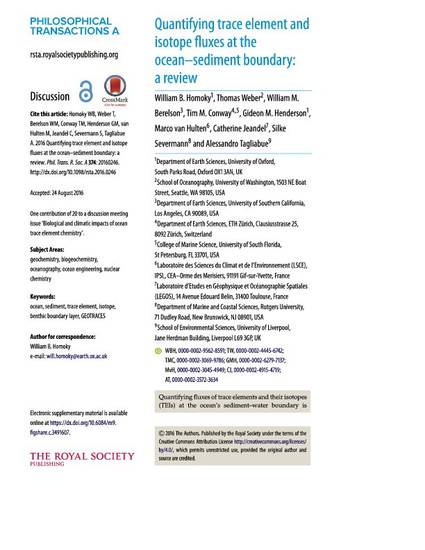
- ocean,
- sediment,
- trace element,
- isotope,
- benthic boundary layer,
- GEOTRACES
Quantifying fluxes of trace elements and their isotopes (TEIs) at the ocean's sediment-water boundary is a pre-eminent challenge to understand their role in the present, past and future ocean. There are multiple processes that drive the uptake and release of TEIs, and properties that determine their rates are unevenly distributed (e.g. sediment composition, redox conditions and (bio)physical dynamics). These factors complicate our efforts to find, measure and extrapolate TEI fluxes across ocean basins. GEOTRACES observations are unveiling the oceanic distributions of many TEIs for the first time. These data evidence the influence of the sediment-water boundary on many TEI cycles, and underline the fact that our knowledge of the source-sink fluxes that sustain oceanic distributions is largely missing. Present flux measurements provide low spatial coverage and only part of the empirical basis needed to predict TEI flux variations. Many of the advances and present challenges facing TEI flux measurements are linked to process studies that collect sediment cores, pore waters, sinking material or seawater in close contact with sediments. However, such sampling has not routinely been viable on GEOTRACES expeditions. In this article, we recommend approaches to address these issues: firstly, with an interrogation of emergent data using isotopic mass-balance and inverse modelling techniques; and secondly, by innovating pursuits of direct TEI flux measurements. We exemplify the value of GEOTRACES data with a new inverse model estimate of benthic Al flux in the North Atlantic Ocean. Furthermore, we review viable flux measurement techniques tailored to the sediment-water boundary. We propose that such activities are aimed at regions that intersect the GEOTRACES Science Plan on the basis of seven criteria that may influence TEI fluxes: sediment provenance, composition, organic carbon supply, redox conditions, sedimentation rate, bathymetry and the benthic nepheloid inventory.
Philosophical Transactions of the Royal Society A: Mathematical, Physical & Engineering Sciences, v. 34, issue 2081
Available at: http://works.bepress.com/tim-conway/23/
